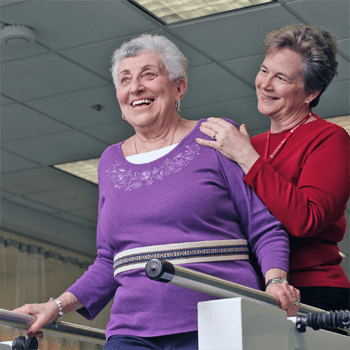Helpful advice from your neighborhood Physical Therapist

CHA physical therapists work with your muscles, joints, and other body parts to help you recover from injuries, medical procedures, or other health conditions.
By Nicholas Wilson, PT, Manager of Ambulatory Rehab and Sports Medicine.
October is National Physical Therapy Month, a great opportunity to recognize the valuable contributions Physical Therapists (PTs) bring to the health and wellness team. A PT uses advanced knowledge in musculoskeletal and neurological conditions, with thorough evaluation and analysis to make precise therapy diagnoses. This connects dysfunction like painful running or weakness lifting overhead, to specific underlying causes like joint stiffness or muscle weakness. The ability to make this connection sets the foundation for successful recovery, addressing the source as well as the symptoms.
A PT works to meet their patient's goals and manage expectations, forming a collaborative plan of care. This may mean running your first marathon, walking down the aisle at your daughter’s wedding, or aging gracefully in your own home. A PT is a coach and guide throughout the rehabilitation process to meet specific goals.
Here are a few helpful tips from your friendly neighborhood PTs:
- Think PRICE – protect, rest, ice, compress and elevate. This supports the healing process immediately following an injury until you are able to seek medical care.
- Stretch smart – before activities like running or team sports, choose dynamic stretches to warm up. Dynamic stretches take you through movement patterns that prepare the body for activity, like walking lunges, jumping jacks or shoulder rotations. Unlike static stretching with holds for 30-90 seconds, these are smooth motions in and out of each position, usually held for under 5 seconds. Static-hold stretching can be beneficial during cool down periods, to increase the range of motion or for maintenance during off days.
- Think outside the knee – painful knees are very common, particularly among runners, basketball players and laborers. In many cases, the cause of knee pain may originate from above or below the knee. Tight hips, stiff ankles or a weak core can place significantly more stress at the knee during activity. This concept rings true in many regions of the body, a skilled PT can identify where to target treatment for optimal long-term results.
- This is your brain on pain – the presence of pain triggers changes in brain chemistry and remains, at times, long after tissue healing has occurred. This does not mean the pain is in your head, this means your brain has adapted to the environment, dedicating more resources to detecting and monitoring pain. The cycle can be disrupted through a thoughtful movement and exercise strategy, putting pain in the back seat and eventually the rearview mirror. A PT uses skillful program building to manage pain thresholds and to help you get moving again.
- If it makes you happy – rarely will a PT tell you to quit what you love, we pride ourselves on creativity and adaptability. If you love to run, we want to keep you running in the safest possible way. In many cases, a little compromise and coaching can keep you out there doing your thing for years to come.
Disclaimer
This articles provide general information for educational purposes only. The information provided in this article, or through linkages to other sites, is not a substitute for medical or professional care, and you should not use the information in place of a visit, call consultation or the advice of your physician or other healthcare provider.